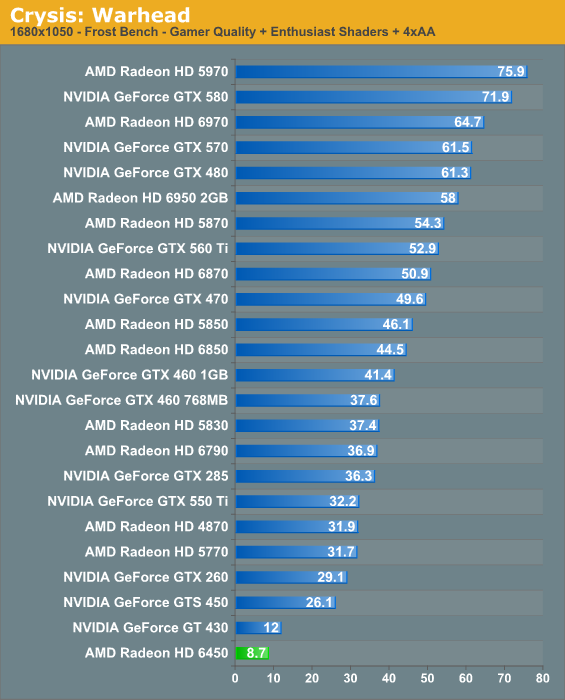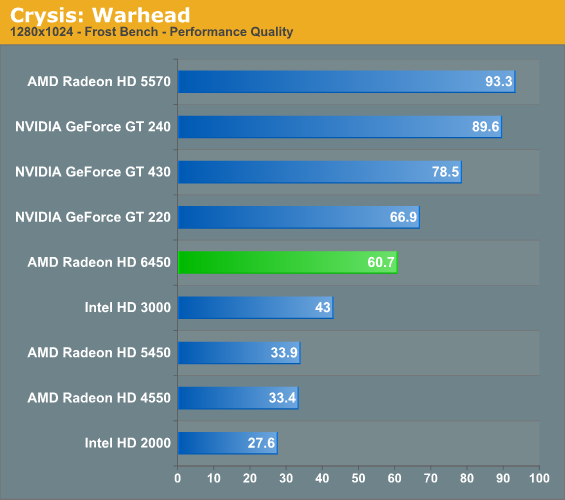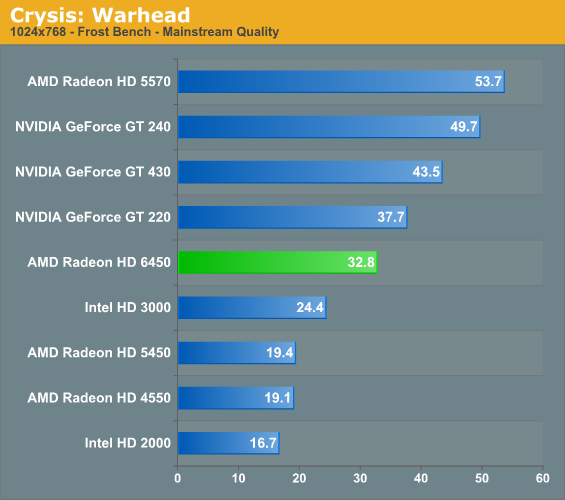AMD's Radeon HD 6450: UVD3 Meets The HTPC
by Ryan Smith on April 7, 2011 12:01 AM ESTCrysis: Warhead
Kicking things off as always is Crysis: Warhead, still one of the toughest games in our benchmark suite. Even three years since the release of the original Crysis, “but can it run Crysis?” is still an important question, and for three years the answer was “no.” Dual-GPU halo cards can now play it at Enthusiast settings at high resolutions, but for low-end cards even Mainstream/Medium quality is nearly out of reach.



We’re throwing in a 1680 chart now and then just to showcase where the Radeon HD 6450 and GT 430 stack up compared to our usual bulk of cards. It takes a lot of cutting to make a $50 card, and the end result is a fraction the performance of a $100 card.
Moving on to more playable settings, we first look at 1280x1024 at the lowest quality setting: Performance. The drop in quality between Performance and Mainstream is quite severe, so once we get to 1024 at Mainstream you’ll understand why we’re using Performance here. In any case the Radeon HD 6450 is actually very playable at this resolution in exchange for the limited graphical quality. Crysis can be quite easy to run, you just have to give up the fancy graphics to get there. Compared to the 5450 the performance jump is quite remarkable; even though the 6450 only has an equal number of ROPs, the jump nearly matches the twofold increase in SPs. So for Crysis we’re definitely shader and/or bandwidth limited.
At 1024x768 mainstream quality, the performance drops across the board in spite of the lower resolution. The 6450 is the first card to crack 30fps, and at 32.9fps it’s only barely playable. The performance gains versus the 5450 are still over 50%, but it’s not quite the large gap we saw at 1280. As for the 5570, here it’s ahead of the 6450 by 20fps. And this is the main problem the 6450 is going to face in the performance race: cheap 5570 cards with more than twice the horsepower are going to easily overpower it. The 6450’s advantage is in power consumption and all that follows.










47 Comments
View All Comments
lukechip - Thursday, April 7, 2011 - link
In the April 2011 Video Card MSRP list, you've omitted the Radeon HD 6950 2GB. Given that this was the first 6950, and in my mind, the 'real' 6950, why is it not listed ?Ryan Smith - Thursday, April 7, 2011 - link
The MSRP list isn't mean to be a definitive list of every card at every price point; but still, that was a rather silly omission. I've since added it.ImSpartacus - Thursday, April 7, 2011 - link
Also missed the GTX 590, but I understand that the purpose of the chart was to show the 6450's position, not to be completely and ultimately definitive.Ryan Smith - Thursday, April 7, 2011 - link
No, that would be because I'm an idiot.The chart was taken from the GTX 550 Ti article, which predated the 590 (which is why it's not there).
GeorgeH - Thursday, April 7, 2011 - link
This might be a great HTPC card for an existing box, but unless AMD has seriously screwed up I can't see this card being terribly attractive for much of anything once Llano ships.ImSpartacus - Thursday, April 7, 2011 - link
I would've liked to see some discussion on that topic. Llano will probably be pitiful on the CPU end, but if they can cram a strong GPU into the product, these $50 GPUs will eventually become extinct.starfalcon - Thursday, April 7, 2011 - link
I suppose with Llano and Ivy Bridge, discrete graphics for HTPC use will essentially be extinct.For gaming I wonder if they will be willing to release any low end graphics that can be beaten by IGPs, if not, then I wonder what the lowest end cards they will release will be.
vol7ron - Thursday, April 7, 2011 - link
I agree, unless they will be used in other ways. I'm not sure what max resolution IGPs can support. Also, I'm sure if you use the HTPC as more of a PC than HT, you will probably need the additional parallel processing (or dedicated GPU).All-in-all these cards remind me of dedicated cards from the 90s :)
starfalcon - Friday, April 8, 2011 - link
I know IGPs can do 2560x1600.With Sandy Bridge I think it only can do it with display port but besides that 1920x1200 with HDMI/DVI. Shouldn't be a problem.
What will you need the additional parallel processing for?
Or dedicated GPU?
Sandy Bridge supports quick sync and Llano should have lots of processing capabilities, Ivy Bridge should have more and more stuff also.
vol7ron - Sunday, April 10, 2011 - link
Say you're playing a game, want to put it on pause and watch some TV, or have multiple display setups and want to watch TV while playing a game. Add a DVR capture card and you'll be need more CPU and GPU processing.I'm just not sure how great the performance would be. Especially assuming you wanted to attach this to a 46"+ display. It might be "capable", but we all know that word is very misleading and quality is hard define when you don't see it with your own eyes.